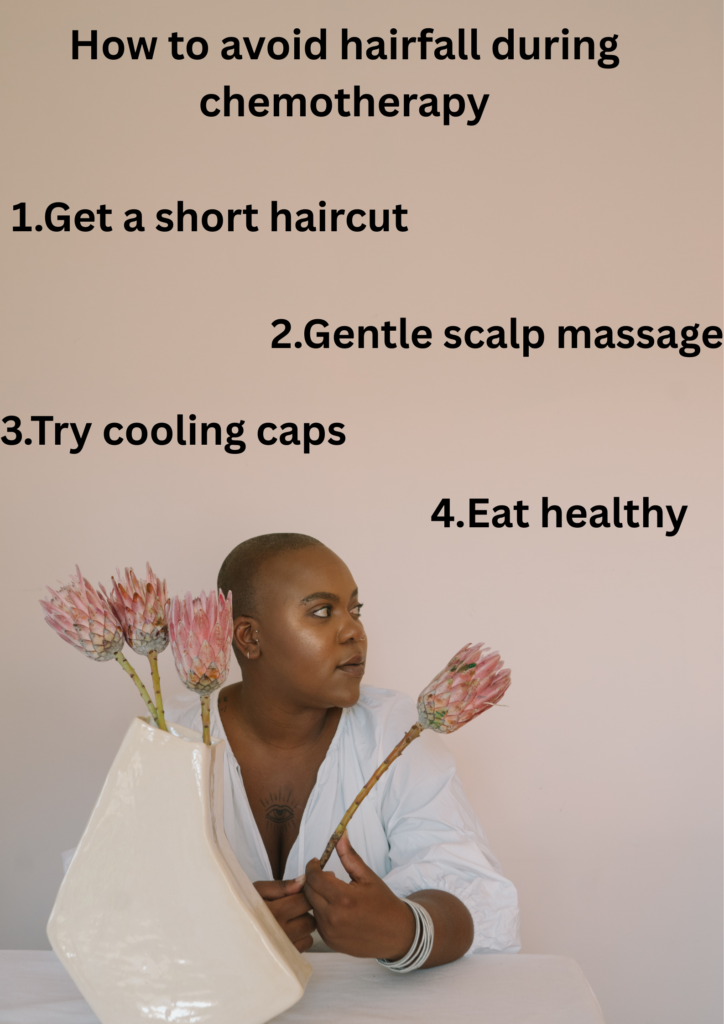Last updated on August 9th, 2025 at 03:15 pm
Chemotherapy is a powerful treatment used to fight cancer. However, it comes with many side effects—hair loss is one of the most visible and distressing ones. But there’s good news: a special method called scalp cooling can help reduce this hair loss. Let’s explore how it works and how you can use it during treatment.
Why Does Chemotherapy Cause Hair Loss?
Chemotherapy targets fast-growing cells, which include cancer cells. Unfortunately, hair follicles also grow quickly, so they get affected too. The chemo drugs attack these cells, causing hair to fall out. This can happen not just on your head but also on eyebrows, eyelashes, and body hair.
Hair loss usually begins within two to three weeks after starting treatment. For many, it can be a painful emotional experience. That’s why tools like cooling caps and scalp cooling systems can feel like magic—they give patients a way to fight back.

What Are Cooling Caps?
Cooling caps, also known as cold caps or scalp cooling caps, are special caps worn on the head before, during, and after chemotherapy. These caps are either filled with cold gel or connected to a machine that circulates cold liquid.
The idea is simple but smart: cool the scalp to protect your hair.
How Do They Work?
When the cap cools your scalp, it shrinks the blood vessels near the surface. This means less chemo medicine reaches the hair roots, and the hair follicles stay healthier. Cooling also slows down the activity of the follicles, making them less likely to absorb the harmful drugs.
As a result, you can keep more of your hair, or experience only partial thinning.
What Are Scalp Cooling Systems?
While manual cooling caps are changed every 20–30 minutes, scalp cooling machines offer a more advanced option. These systems keep a steady, controlled temperature throughout the session. Some of the most trusted systems include:
- DigniCap
- Paxman Scalp Cooling
- Penguin Cold Cap System
- Arctic Cold Caps
These are available in many hospitals and clinics around the world. Some also offer rentals for home use.
How to Use Cooling Caps during chemotherapy
Here’s a quick step-by-step:
- Wear the cap 30–45 minutes before chemotherapy starts.
- Keep it on during the entire infusion.
- Continue wearing it for up to 90 minutes after chemo ends.
This total cooling time protects the follicles before, during, and after the medicine flows through your body.
Does It Really Work?
Yes. Research and real patient stories show that scalp cooling reduces hair loss for many people. Success depends on the type of chemo drugs used and the person’s hair type, but many report keeping 50%–70% of their hair.
Side Effects and Tips
Some people may feel:
- Cold or shivering
- Headaches
- Pressure on the scalp
To stay comfortable, bring a blanket, socks, or warm drinks. Listening to music or guided meditation can also help pass the time.
Where to Buy or Rent Cooling Caps
You can order or rent cooling caps from several trusted companies:
- 🌐 Penguin Cold Caps – Offers personal support and training.
- 🌐 Capillus Cold Caps – Easy-to-use caps for home or clinic.
- 🌐 Arctic Cold Caps – Includes coaching and rental kits.
- Ask your hospital or oncologist about DigniCap or Paxman availability.
What to Expect After Treatment
Even if you use cooling caps, some hair shedding is still normal. However, the difference is clear—you’ll likely keep much of your hair, and this makes recovery emotionally easier.
Also, here’s the real magic: after treatment, your hair will grow back faster, and in the same density and thickness as before. The hair follicles stay healthy enough to recover naturally.
Final Words
Chemotherapy can take a toll on both body and mind. But thanks to scalp cooling, you now have a powerful way to protect your hair and boost your confidence. It’s not just about looks—it’s about feeling strong, brave, and more like yourself.
If you’re starting chemotherapy, talk to your doctor about scalp cooling. This small step could make a big difference in your journey.
Faqs
What is the difference between before and after chemotherpy hairloss with or without cooling caps
✅ With Cooling Caps (Scalp Cooling)
Before Chemotherapy:
You may choose to get a short haircut to make shedding less noticeable.
You begin wearing the cooling cap 30–45 minutes before treatment starts.
During Chemotherapy:
Cooling cap stays on to keep scalp cold, reducing blood flow and drug delivery to hair follicles.
Hair follicles are protected from chemo damage.
After Chemotherapy:
Partial hair loss or thinning may occur (often 20–50% hair loss).
Many people keep visible hair, which helps emotional well-being.
Hair tends to grow back faster, with the same density and quality.
Regrowth starts more evenly and may need less time to return to normal.
❌ Without Cooling Caps
Before Chemotherapy:
Some people cut their hair short in preparation for total hair loss.
Hair follicles are fully exposed to chemotherapy drugs.
During Chemotherapy:
Hair begins to shed 2–3 weeks after the first session.
Hair loss is usually total or nearly complete (scalp, eyebrows, eyelashes, body hair).
After Chemotherapy:
Hair starts to regrow 2–3 weeks after treatment ends.
It may take 6–12 months to regain full hair length and density.
Hair may come back with a different texture (e.g., curlier or thinner).
will the price of my treatment increase if i use cooling caps
💰 How Cooling Caps Affect Overall Treatment Cost:
✅ What You Might Pay Extra For:
Cap Rental or Purchase: Ranges from $400 to $800 per month for manual caps, or $1,500 to $2,200 for automated systems.
Clinic Fees: Some hospitals charge usage or setup fees per chemo session (around $100–$200).
Dry Ice (for manual systems): Typically $50–$100 per session.
Additional Visits or Time: You may need to stay at the clinic longer before and after each chemo session, which can increase facility usage time.
will the usage of cooling caps to prevent hairloss compromise the efiiciency of chemotherapy
Using cooling caps during chemotherapy does not compromise the effectiveness of the treatment. These caps work by cooling the scalp, which constricts blood vessels and reduces the amount of chemotherapy drugs that reach the hair follicles—helping protect them from damage and minimizing hair loss. However, this cooling effect is localized only to the scalp and does not impact how the drugs circulate through the rest of the body or reach the cancer cells. Clinical studies have shown that scalp cooling is safe and effective for many types of solid tumors, such as breast, ovarian, and prostate cancers, and it does not reduce the cancer-fighting ability of chemotherapy. That said, cooling caps are generally not recommended for blood cancers like leukemia or lymphoma, where cancer cells may be present in the scalp and reducing chemo exposure there might carry risks. Oncologists carefully assess each patient’s case to ensure scalp cooling is appropriate. In most cases, for eligible patients, cooling caps offer a safe way to reduce hair loss without affecting treatment outcomes.
Can I use cooling caps even if i have metastatic cancer
Yes, you can often use cooling caps even if you have metastatic cancer, but it depends on the type and location of your cancer as well as your oncologist’s guidance. Cooling caps are generally considered safe for patients with metastatic solid tumors, such as metastatic breast, ovarian, or prostate cancer. In these cases, the cancer has spread to other parts of the body but not typically to the scalp, and since cooling caps only affect blood flow to the scalp, they do not interfere with the treatment of cancer elsewhere in the body. However, if you have a type of cancer that spreads through the blood or lymph system, such as leukemia, lymphoma, or other blood-related cancers, scalp cooling is usually not recommended. This is because of a potential risk that cooling the scalp might create a sanctuary area where chemotherapy drugs are less effective, possibly allowing cancer cells to survive there. This concern is rare but taken seriously in certain types of cancer. Ultimately, if you have metastatic cancer, the decision to use cooling caps should be made with your oncology team, who can assess the specific characteristics of your cancer, whether it has spread to the scalp or brain, and whether scalp cooling is a safe and appropriate option for you. In many cases, especially with solid tumors, patients are able to use cooling caps successfully to help reduce hair loss.




